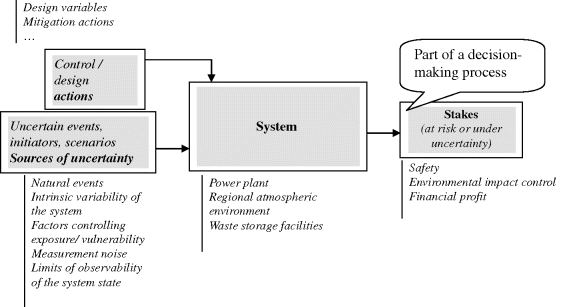3 The Generic Methodological Approach of the Book
Notwithstanding such diversity of origins of uncertainty and risk phenomena within natural or man-made systems, this book will show that associated studies do involve similar key steps and a range of mathematical synergies. Indeed, quite distinct options remain regarding the peculiar choice of mathematical representation of uncertainty: this depends on the nature of the system and the precise specification of the variables of interest for the decision-maker. But the following generic framework will be a recurring concept throughout the book: the stakes in decision-making involve the control of the key outputs of interest of a system and the optimisation of associated actions (or designs, operation options . . .) faced with uncertainty in the states of the system (Figure 5).
Figure 5 The pre-existing or system model and its inputs/outputs.

Risk/uncertainty-conscious modelling mobilises a range of statistical, physical and numerical techniques designed to encode data and expertise in a combined phenomenological and probabilistic model (system and uncertainty model). This is meant to best represent the behaviour of the system outputs of interest under uncertainty given the variables of interest for the decision-maker and the scope of possible actions; hence, it aims to support valuable or accountable decisions – formally selecting ...
Get Modelling Under Risk and Uncertainty: An Introduction to Statistical, Phenomenological and Computational Methods now with the O’Reilly learning platform.
O’Reilly members experience books, live events, courses curated by job role, and more from O’Reilly and nearly 200 top publishers.

